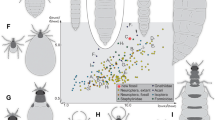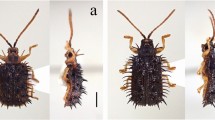Abstract
The cavities of bamboos (Poaceae) are used by various animals. Most of the animals access these cavities either by existing cracks or by excavating bamboos with soft walls or small, thin-walled bamboos. Only a few animals excavate into the cavities of large and thick- and hard-walled internodes of mature bamboos. We studied two lizard beetle species (Coleoptera: Erotylidae: Languriinae), Doubledaya ruficollis and Oxylanguria acutipennis, that excavate into large internode cavities of recently dead mature bamboos and have morphological modifications. We observed that females of D. ruficollis used their mandibles to bore oviposition holes on Schizostachyum sp. (mean wall thickness = 3.00 mm) and O. acutipennis did so on Dendrocalamus sp. (3.37 mm) bamboos. Previous studies suggested that the markedly asymmetrical mandibles and needle-like ovipositors of females in the genus Doubledaya are adaptive traits for excavating hard-walled bamboos for oviposition. Therefore, we measured their mandibular lengths and ovipositor lengths. D. ruficollis females had greater asymmetry in the mandibles and shorter and less-sclerotized ovipositors than females of congeners using small bamboos. In contrast, O. acutipennis females had slightly asymmetrical mandibles and elongated, well-sclerotized ovipositors. Oviposition holes of D. ruficollis were cone-shaped (evenly tapering), whereas those of O. acutipennis were funnel-shaped (tube-like at the internal apex). This suggests that D. ruficollis females excavate oviposition holes using the mandibles only, and O. acutipennis females use both the mandibles and ovipositors. These differences suggest different oviposition-associated morphological specialization for using large bamboos: the extremely asymmetrical mandibles in D. ruficollis and elongated, needle-like ovipositors in O. acutipennis.



Similar content being viewed by others
References
Crotch GR (1876) A revision of the coleopterous family Erotylidae. Cistula Entomol 1:377–562
Dajoz R (2000) Insects and forests: the role and diversity of insects in the forest environment. Intercept, London
Fiala B, Maschwitz U (1992) Domatia as most important adaptations in the evolution of myrmecophytes in the paleotropical tree genus Macaranga (Euphorbiaceae). Pl Syst Evol 180:53–64
Gardner JCM (1945) A note on the insect borers of bamboos and their control. Indian Forest Bul 125:0–17. 3 plts
Genung WG, Eoodruff RE, Grissell EE (1980) Languria erythrocephalus: host plants, immature stages, parasites, and habits (Coleoptera: Languriidae). Fla Entomol 63:206–210
Gibbons P, Lindenmayer D (2002) Tree hollows and wildlife conservation in Australia. Csiro Publishing, Collingwood
Hongjamrassilp W, Warrit N (2014) Nesting biology of an oriental carpenter bee, Xylocopa (Biluna) nasalis Westwood, 1838, in Thailand (Hymenoptera, Apidae, Xylocopinae). J Hymenopt Res 41:71–94
Hoso M, Asami T, Hori M (2007) Right-handed snakes: convergent evolution of asymmetry for functional specialization. Biol Lett 3:169–172
Kanzaki S (1938) Notes on Niphona furcata. Mushino-sekai 133:119–121 [In Japanese]
Kojima K (1955) Determination of the larval instar of Niphona frucata. Res Rep Kochi Univ 3:1–6
Kovac D, Krocke M (2013) Biology of the bamboo-inhabiting semi-aquatic bugs Lathriovelia rickmersi Kovac & Yang and L. capitata Andersen (Insecta: Heteroptera: Veliidae) and habitat specialisation in the Oriental Baptista / Lathriovelia complex. Raffles Bull Zool Suppl 29:49–70
Kovac D, Yong HS (1992) Abryna regispetri - a bamboo long-horned beetle. Nat Malaysiana 17:92–98
Kraatz G (1899) Einige Bemerkungen zu Gorham’s Aufsatz von 1896: Languridae in Birmania ex regione vicina a Leonardo Fea collecta. Deuts Ent Zeitschr 1899:345–352
Medway L, Marshall AG (1970) Roost-site selection among flat-headed bats (Tylonycteris spp.). J Zool (Lond) 161:237–245
Palmer AR (2005) Antisymmetry. In: Hallgrímmson B, Hall BK (eds) Variation. Elsevier, Amsterdam, pp 359–397
R Development Core Team (2017) R: a language and environment for statistical computing. R Foundation for Statistical Computing, Vienna
Round PD, Hobday JM, Kanjanavanit R, Steward JS (2012) A nesting pair of Gecinulus woodpeckers in a likely zone of intergradation between pale-headed woodpecker G. grantia and bamboo woodpecker G. viridis. Forktail 28:113–120
Schneider CA, Rasband WS, Eliceiri KW (2012) NIH Image to ImageJ: 25 years of image analysis. Nat Methods 9:671–675
Toki W, Togashi K (2011) Exaggerated asymmetric head morphology of female Doubledaya bucculenta (Coleoptera: Erotylidae: Languriinae) and ovipositional preference for bamboo internodes. Zool Sci 28:348–354
Toki W, Togashi K (2013) Relationship between oviposition site selection and mandibular asymmetry in two species of lizard beetles, Anadastus pulchelloides Nakane and Doubledaya bucculenta Lewis (Coleoptera: Erotylidae: Languriinae). Coleopt Bull 67:360–367
Toki W, Tanahashi M, Togashi K, Fukatsu T (2012) Fungal farming in a non-social beetle. PLoS One 7:e41893
Toki W, Takahashi Y, Togashi K (2013) Fungal garden making inside bamboos by a non-social fungus-growing beetle. PLoS One 8:e79515
Toki W, Matsuo S, Pham HT, Yoshitomi H (2014) Morphology of adults and immature stages and host plant use of Doubledaya sinuata (Coleoptera: Erotylidae: Languriinae). Acta Entomol Mus Nat Pragae 54:623–634
Toki W, Pham HT, Togashi K (2016) Relationship between mandibular asymmetry, oviposition hole, and oviposition substrate hardness in two bamboo-using lizard beetles Doubledaya tonkinensis and D. sinuata (Coleoptera: Erotylidae: Languriinae). Ann Entomol Soc Am 109:850–859
Villiers A (1945) Révision des Languriides de l’Ancien Monde. L’Abeille 37:1–317
Acknowledgments
We wish to thank Shu-Ching Chen, Edmund Hang, Tomoki Hirano, Tuan Anh Hoang, Takao Itioka, Kunpeng Liu, Van Hien Luong, Ko Mochizuki, Ryosuke Okano, Usun Shimizu-Kaya, Fusako Toki, Thi Men Tran, and Hiroyuki Yoshitomi for help with the field work, Nguyen Khac Khoi and Chin-Ming Lu for identification of Vietnamese bamboos, Ryutaro Iwata for the literature, and Yoshihiro Senda, Keizo Takasuka, and Katsumi Togashi for helpful information. We also thank Cuc Phuong National Park, Vietnam, and Lambir Hills National Park, Sarawak, Malaysia, for allowing us to conduct the field survey.
Funding
This study was supported by the Fujiwara Natural History Foundation, a Grant for Basic Science Research Projects from the Sumitomo Foundation (170744), a KAKENHI Grant (25840153, 18K14473) from the Japan Society for the Promotion of Science (JSPS), and the Vietnam National Foundation for Science and Technology Development (NAFOSTED) (106-NN.05-2016.04). WT was supported by a JSPS Grant-in-Aid for JSPS Fellows (201501207).
Author information
Authors and Affiliations
Corresponding author
Ethics declarations
Conflict of interest
The authors declare that they have no conflict of interest.
Ethical approval
All applicable international, national, and/or institutional guidelines for the care and use of animals were followed.
Additional information
Communicated by: Paula Roig Boixeda
Publisher’s note
Springer Nature remains neutral with regard to jurisdictional claims in published maps and institutional affiliations.
Rights and permissions
About this article
Cite this article
Toki, W., Matsuo, S., Pham, H.T. et al. Heads or tails: exaggerated morphologies in relation to the use of large bamboo internodes in two lizard beetles, Doubledaya ruficollis and Oxylanguria acutipennis (Coleoptera: Erotylidae: Languriinae). Sci Nat 106, 50 (2019). https://doi.org/10.1007/s00114-019-1645-6
Received:
Revised:
Accepted:
Published:
DOI: https://doi.org/10.1007/s00114-019-1645-6




